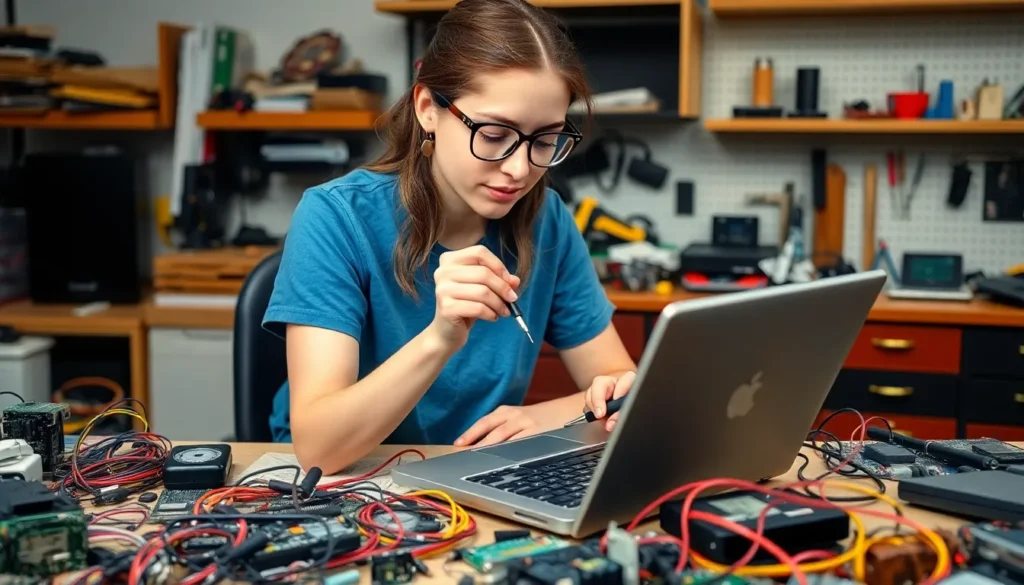In a world obsessed with the latest gadgets, it’s easy to overlook the charm of old hardware. But what if that dusty relic in the corner still has some life left in it? Repairing old hardware isn’t just a nostalgic trip down memory lane; it’s a chance to save money and reduce electronic waste. Plus, nothing beats the satisfaction of breathing new life into something that’s been gathering dust for years.
Table of Contents
ToggleImportance Of Repairing Old Hardware
Repairing old hardware significantly reduces electronic waste. Each repaired device contributes to minimizing the environmental impact of discarded electronics. By reviving outdated devices, individuals alleviate the burden on landfills.
Cost savings play a crucial role in the decision to repair. Often, replacing hardware involves considerable expenses, while repairs typically cost less. For instance, fixing a broken laptop can extend its lifespan, saving money over time.
In addition to financial advantages, revitalizing old equipment enhances technical skills. Many individuals learn valuable repair techniques through hands-on experience. Such skills foster greater confidence in handling future hardware issues.
Restoring old hardware offers personal satisfaction. The act of breathing new life into forgotten gadgets can evoke a sense of achievement. Many hobbyists find joy in the challenge of restoring functionality to devices once deemed obsolete.
Moreover, older hardware often retains sentimental value. Items passed down through generations hold memories worth preserving. By repairing these devices, individuals honor their history and maintain connections to the past.
Another benefit includes supporting a circular economy. Repairing and reusing devices promotes a sustainable approach to technology consumption. Engaging in repairs encourages others to rethink their consumption habits.
Communities also benefit from repair initiatives. Repair cafes and workshops foster collaboration and knowledge-sharing among enthusiasts. Such gatherings strengthen community ties and inspire collective efforts towards sustainability.
Repairing old hardware proves vital for economic and environmental reasons. The cumulative impact of individual actions contributes to a larger movement advocating for sustainable technology practices.
Common Issues With Old Hardware

Old hardware encounters various issues that impact usability and functionality. Understanding these common problems can guide effective repair strategies.
Physical Wear And Tear
Physical wear and tear often affects older devices, leading to hardware malfunctions. Components like keyboards, ports, and screens may show signs of damage such as sticking keys or cracked displays. Dust accumulation can hinder ventilation, causing overheating and performance drops. Users must assess these damages before proceeding with repairs. For instance, replacing worn-out keyboards or cleaning internal parts can restore device functionality.
Software Compatibility
Software compatibility frequently poses challenges for old hardware. New operating systems may not support outdated components, leading to performance issues. Legacy software can fail to run properly on updated platforms, creating hurdles for users. Upgrading RAM or using compatibility modes may help address some problems. Additionally, running lightweight alternatives can extend usability for aging devices. Empirical data shows that updating drivers is crucial for maintaining compatibility, ensuring optimal performance on older machines.
Tools And Materials Needed
Repairing old hardware requires specific tools and materials to ensure successful results. Having the right equipment makes the process more efficient and effective.
Essential Tools
Common tools for hardware repair include screwdrivers, pliers, and tweezers. Precision screwdrivers come in various sizes, allowing access to different screws on devices. Pliers assist in gripping small components for careful manipulation. A static-free wrist strap protects sensitive parts from electrostatic discharge. Additionally, a multimeter measures voltage and continuity, helping diagnose electrical issues. These essential tools help ensure a smooth repair experience.
Recommended Replacement Parts
Key replacement parts enhance the functionality of older devices. For computers, RAM upgrades significantly improve performance. Hard drive replacements, such as SSDs, offer faster data access and reliability. Laptop batteries often require replacement due to limited lifespan, providing improved mobility once swapped out. For peripherals, replacing keyboards and mice with compatible models restores usability. Ensuring these parts fit the specific device model is crucial for successful repairs.
Step-By-Step Repair Guide
Repairing old hardware requires a structured approach. This guide outlines essential steps for diagnosing issues, performing repairs, and applying advanced techniques.
Diagnosing The Problem
Start by identifying any physical damage such as cracks or loose components. Check for internal dust accumulation that may cause overheating. Observe whether the device powers on and if the software operates efficiently. Use a multimeter to verify electrical connectivity in cases of malfunctioning parts. Consider common signs such as unusual noises or poor performance as indicators of underlying problems. Knowing these issues assists in determining the type of repair necessary.
Performing Simple Repairs
Replace worn-out components to improve functionality. Swapping out keyboards, replacing batteries, or installing additional RAM can yield significant performance gains. Begin by carefully disassembling the device using precision screwdrivers. Always keep track of screws and small parts during the process. Ensure compatibility when obtaining new parts for various device models. Cleaning internal components with compressed air prevents dust buildup and overheating. These simple steps restore the usability of aging devices without extensive technical knowledge.
Advanced Repair Techniques
Tackle more complex issues with advanced repair methods. Soldering new connections may be necessary for damaged circuit boards. Upgrade hard drives to SSDs for enhanced speed and reliability. Follow online guides or video tutorials specific to the device for detailed instructions. Assess software compatibility by using virtualization software to run lightweight operating systems. Taking on these techniques requires patience and practice but can significantly extend the life of old hardware.
Benefits Of Repairing Old Hardware
Repairing old hardware offers significant cost savings compared to buying new devices. Often, repairs cost much less than replacements. Reducing electronic waste presents another vital advantage while contributing to environmental sustainability. Many discarded electronics end up in landfills, but repair extends the life of these gadgets.
Enhancing technical skills comes naturally through hands-on repairs. Individuals not only learn new capabilities but also develop problem-solving strategies while tackling hardware issues. Experiencing satisfaction from restoring functionality adds to the appeal of repairing older devices.
Sentimental value factors heavily into the decision to repair. Many older devices carry memories, making their preservation worthwhile. Nurturing a personal connection to technology fosters appreciation for older hardware.
Supporting a circular economy plays a crucial role in repairing old devices. Encouraging repair and reuse enables a shift toward sustainable technology consumption. Communities benefit from initiatives like repair cafes, which promote collaboration and knowledge sharing among enthusiasts.
Addressing common hardware issues becomes easier when users commit to repair. Physical wear and tear affects both usability and performance. Dust accumulation often leads to overheating, yet tidying up internal components enhances device longevity.
Tools and materials for repairs become essential for effective restoration. Using precision screwdrivers, pliers, and multimeters allows users to diagnose and fix issues more easily. Identifying and securing the right replacement parts maximizes the success of repairs.
Following a step-by-step approach for diagnostics ensures clarity during the repair process. Users identify physical damage and assess electrical connectivity before attempting repairs. Delving into online resources for more complex repairs can lead to greater achievements in restoring old hardware.
Repairing old hardware isn’t just about saving money; it’s about embracing sustainability and fostering a sense of community. By choosing to revive outdated devices, individuals contribute to reducing electronic waste while enhancing their technical skills. Each repair can spark creativity and innovation, allowing users to rediscover the potential of their forgotten gadgets.
As the movement for sustainable technology continues to grow, supporting repair initiatives can lead to a more environmentally conscious society. Every effort to fix old hardware not only preserves memories but also champions a circular economy that values reuse over disposal. Embracing this practice can transform the way people view technology and its role in their lives.




